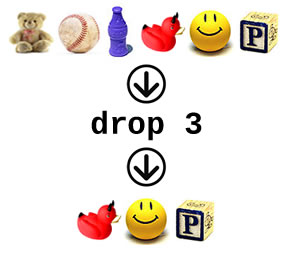
Enumerating Enumerable marches on!
This is the seventh article in my series in which I try to do a better job of documenting Ruby’s Enumerable module than Ruby-Doc.org does. If you’ve missed the other articles in the series, they’re listed below:
In this installment, I cover a method added in Ruby 1.9: drop.
Enumerable#drop Quick Summary

| In the simplest possible terms | Given a collection and a number n, create an array made of the items of the collection with the first n items removed. |
|---|---|
| Ruby version | 1.9 only |
| Expects | The number of elements to remove from the start of the collection. |
| Returns | An array made up of the remaining items, if there are any./td> |
| RubyDoc.org’s entry | Enumerable#drop |
Enumerable#drop and Arrays
With an array, drop takes a number n as an argument and returns an array created by removing the first n elements of the array. The resulting array is made up of the remaining elements.
# These are the favourite bands of RubyFringe organizer # Meghan Katleen Millard's, according to her Facebook profile meghans_fave_bands = ["Afghan Whigs", "Bjork", "Charles Mingus", "Deerhunter", "Electrelane", "Francois Hardy", "Godspeed You Black Emperor!"] => ["Afghan Whigs", "Bjork", "Charles Mingus", "Deerhunter", "Electrelane", "Francois Hardy", "Godspeed You Black Emperor!"] # Let's lose the first 5 meghans_fave_bands.drop 5 => ["Francois Hardy", "Godspeed You Black Emperor!"] # The original array is not affected meghans_fave_bands => ["Afghan Whigs", "Bjork", "Charles Mingus", "Deerhunter", "Electrelane", "Francois Hardy", "Godspeed You Black Emperor!"]
Enumerable#drop and Hashes
With an hash, drop takes a number n as an argument and returns an array created by removing the first n elements of the array (drop is only in Ruby 1.9 and later, where hashes keep the order in which they were defined, so its results are predictable). The resulting array is made up of the remaining elements, with each element converted into a two-element array where element 0 is the key and element 1 is the corresponding value.
# Here's a hash of the first five U.S. states
# (in terms of alphabetical order) and their capitals.
# This example is in Ruby 1.9, which means that
# the hash keys will stay in the order in which
# they were defined.
states_and_capitals = {"Alabama" => "Montgomery", \
"Alaska" => "Juneau", \
"Arizona" => "Phoenix", \
"Arkansas" => "Little Rock", \
"California" => "Sacramento"}
=> {"Alabama"=>"Montgomery", "Alaska"=>"Juneau", "Arizona"=>"Phoenix",
"Arkansas"=>"Little Rock", "California"=>"Sacramento"}
# Let's remove the first 3
states_and_capitals.drop 3
=> [["Arkansas", "Little Rock"], ["California", "Sacramento"]]
# The original hash is not affected
states_and_capitals
=> {"Alabama"=>"Montgomery", "Alaska"=>"Juneau", "Arizona"=>"Phoenix",
"Arkansas"=>"Little Rock", "California"=>"Sacramento"}
Enumerable#take: Enumerable#drop’s Evil Twin
I’ll cover take in detail in a later installment, but for now, an example should suffice:
meghans_fave_bands = ["Afghan Whigs", "Bjork", "Charles Mingus", "Deerhunter", "Electrelane", "Francois Hardy", "Godspeed You Black Emperor!"] => ["Afghan Whigs", "Bjork", "Charles Mingus", "Deerhunter", "Electrelane", "Francois Hardy", "Godspeed You Black Emperor!"] # drop(n) removes the first n elements meghans_fave_bands.drop(4) => ["Electrelane", "Francois Hardy", "Godspeed You Black Emperor!"] meghans_fave_bands.take(4) => ["Afghan Whigs", "Bjork", "Charles Mingus", "Deerhunter"]